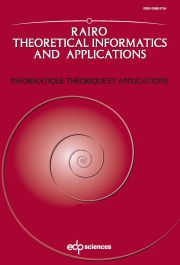Crossref Citations
This article has been cited by the following publications. This list is generated based on data provided by Crossref.
Selivanov, Victor L.
2002.
Relating Automata-theoretic Hierarchies to Complexity-theoretic Hierarchies.
RAIRO - Theoretical Informatics and Applications,
Vol. 36,
Issue. 1,
p.
29.
Borchert, Bernd
Lange, Klaus-Jörn
Stephan, Frank
Tesson, Pascal
and
Thérien, Denis
2004.
Developments in Language Theory.
Vol. 3340,
Issue. ,
p.
89.
Selivanov, Victor L.
and
Wagner, Klaus W.
2004.
Mathematical Foundations of Computer Science 2004.
Vol. 3153,
Issue. ,
p.
783.
Glaßer, Christian
2005.
STACS 2005.
Vol. 3404,
Issue. ,
p.
170.
Wagner, Klaus W.
2005.
Machines, Computations, and Universality.
Vol. 3354,
Issue. ,
p.
60.
Selivanov, Victor L.
and
Wagner, Klaus W.
2005.
A reducibility for the dot-depth hierarchy.
Theoretical Computer Science,
Vol. 345,
Issue. 2-3,
p.
448.
BORCHERT, BERND
LANGE, KLAUS-JÖRN
STEPHAN, FRANK
TESSON, PASCAL
and
THÉRIEN, DENIS
2005.
THE DOT-DEPTH AND THE POLYNOMIAL HIERARCHIES CORRESPOND ON THE DELTA LEVELS.
International Journal of Foundations of Computer Science,
Vol. 16,
Issue. 04,
p.
625.
Selivanov, Victor L.
2005.
New Computational Paradigms.
Vol. 3526,
Issue. ,
p.
430.
Glaßer, Christian
Travers, Stephen
and
Wagner, Klaus W.
2006.
Developments in Language Theory.
Vol. 4036,
Issue. ,
p.
408.
Glaßer, Christian
and
Travers, Stephen
2006.
Mathematical Foundations of Computer Science 2006.
Vol. 4162,
Issue. ,
p.
436.
Glaßer, Christian
Ogihara, Mitsunori
Pavan, A.
Selman, Alan L.
and
Zhang, Liyu
2007.
Autoreducibility, mitoticity, and immunity.
Journal of Computer and System Sciences,
Vol. 73,
Issue. 5,
p.
735.
Glaßer, Christian
2007.
Languages polylog-time reducible to dot-depth 1/2.
Journal of Computer and System Sciences,
Vol. 73,
Issue. 1,
p.
36.
Selivanov, Victor L.
2008.
Fine hierarchies and m-reducibilities in theoretical computer science.
Theoretical Computer Science,
Vol. 405,
Issue. 1-2,
p.
116.
Glaßer, Christian
and
Travers, Stephen
2009.
Machines that Can Output Empty Words.
Theory of Computing Systems,
Vol. 44,
Issue. 3,
p.
369.
Selivanov, Victor L.
2009.
Hierarchies and reducibilities on regular languages related to modulo counting.
RAIRO - Theoretical Informatics and Applications,
Vol. 43,
Issue. 1,
p.
95.
Glaßer, Christian
Travers, Stephen
and
Wagner, Klaus W.
2014.
Perfect correspondences between dot-depth and polynomial-time hierarchies.
Journal of Computer and System Sciences,
Vol. 80,
Issue. 7,
p.
1359.


